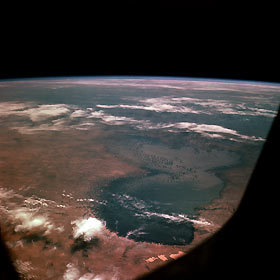
Save this image free of charge
in 800 pixels for layout use
(right click, Save as...)
|
|
Ref : T01100
Theme :
Looking at Earth - Rivers - lakes (517 images)
Title : Lake Chad, Africa October 1968
Caption :
The north and south basins of Lake Chad are visible in this southeast-looking, high-oblique photograph. The boundaries and depth of the lake fluctuate from season to season and year to year. Lake Chad is the 4th largest lake in Africa and the 17th largest lake in the world, covering an area of nearly 6000 square miles (16 000 square kilometers). The average depth of the lake in the north is only 10 feet (3 meters), whereas the average depth in the south is nearly 20 feet (6 meters). The lake is fed by two major rivers, the Chari and the Komadugu Gana, and by many lesser streams; but, it has no outlet. Lake Chad is a freshwater lake, which is very unusual for a desert lake. Located on the southern boundary of the Sahara Desert, Lake Chad contains numerous sand dunes or islets in both its northern and its southern basin. Two million years ago, when the climate was much wetter, Lake Chad covered a large portion of the south-central Sahara Desert. As the climate became drier and some geologic uplifting occurred to the south of the lake, sending rivers that had been draining into the lake southward into the Congo Basin, the lake shrank to little more than 10 percent of its original size. Lake Chad continues to shrink because of droughts that plague that region of Africa. The northern basin, which is almost completely cut off from the southern basin by a ridge known as the Great Barrier, is especially vulnerable to any short-term changes resulting from drought conditions and excessive evaporation.
|
|

